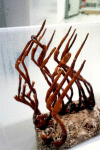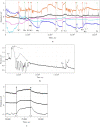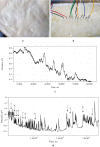Towards fungal sensing skin
- PMID: 33980304
- PMCID: PMC8117569
- DOI: 10.1186/s40694-021-00113-8
Towards fungal sensing skin
Abstract
A fungal skin is a thin flexible sheet of a living homogeneous mycelium made by a filamentous fungus. The skin could be used in future living architectures of adaptive buildings and as a sensing living skin for soft self-growing/adaptive robots. In experimental laboratory studies we demonstrate that the fungal skin is capable for recognising mechanical and optical stimulation. The skin reacts differently to loading of a weight, removal of the weight, and switching illumination on and off. These are the first experimental evidences that fungal materials can be used not only as mechanical 'skeletons' in architecture and robotics but also as intelligent skins capable for recognition of external stimuli and sensorial fusion.
Keywords: Biomaterials; Fungi; Sensing; Sensorial fusion; Soft robotics.
Conflict of interest statement
The authors declare that they have no competing interests.
Figures




Similar articles
-
Fungal sensing skin.Fungal Biol Biotechnol. 2021 Mar 17;8(1):3. doi: 10.1186/s40694-021-00110-x. Fungal Biol Biotechnol. 2021. Retraction in: Fungal Biol Biotechnol. 2021 Jun 02;8(1):7. doi: 10.1186/s40694-021-00114-7. PMID: 33731205 Free PMC article. Retracted.
-
Fungal skin for robots.Biosystems. 2024 Jan;235:105106. doi: 10.1016/j.biosystems.2023.105106. Epub 2023 Dec 19. Biosystems. 2024. PMID: 38128872
-
Actively Perceiving and Responsive Soft Robots Enabled by Self-Powered, Highly Extensible, and Highly Sensitive Triboelectric Proximity- and Pressure-Sensing Skins.Adv Mater. 2018 Jul;30(28):e1801114. doi: 10.1002/adma.201801114. Epub 2018 Jun 4. Adv Mater. 2018. PMID: 29869431
-
Electronic skins and machine learning for intelligent soft robots.Sci Robot. 2020 Apr 22;5(41):eaaz9239. doi: 10.1126/scirobotics.aaz9239. Epub 2020 Apr 22. Sci Robot. 2020. PMID: 33022628 Review.
-
Sensing in Soft Robotics.ACS Nano. 2023 Aug 22;17(16):15277-15307. doi: 10.1021/acsnano.3c04089. Epub 2023 Aug 2. ACS Nano. 2023. PMID: 37530475 Free PMC article. Review.
Cited by
-
Language of fungi derived from their electrical spiking activity.R Soc Open Sci. 2022 Apr 6;9(4):211926. doi: 10.1098/rsos.211926. eCollection 2022 Apr. R Soc Open Sci. 2022. PMID: 35425630 Free PMC article.
-
Risk assessment of fungal materials.Fungal Biol Biotechnol. 2022 Feb 24;9(1):3. doi: 10.1186/s40694-022-00134-x. Fungal Biol Biotechnol. 2022. PMID: 35209958 Free PMC article. Review.
-
Connecting materials sciences with fungal biology: a sea of possibilities.Fungal Biol Biotechnol. 2022 Mar 1;9(1):5. doi: 10.1186/s40694-022-00137-8. Fungal Biol Biotechnol. 2022. PMID: 35232493 Free PMC article.
-
MycelioTronics: Fungal mycelium skin for sustainable electronics.Sci Adv. 2022 Nov 11;8(45):eadd7118. doi: 10.1126/sciadv.add7118. Epub 2022 Nov 11. Sci Adv. 2022. PMID: 36367944 Free PMC article.
-
Retraction Note to: Fungal sensing skin.Fungal Biol Biotechnol. 2021 Jun 2;8(1):7. doi: 10.1186/s40694-021-00114-7. Fungal Biol Biotechnol. 2021. PMID: 34078474 Free PMC article. No abstract available.
References
-
- Ma M, Zhang Z, Liao Q, Yi F, Han L, Zhang G, Liu S, Liao X, Zhang Y. Self-powered artificial electronic skin for high-resolution pressure sensing. Nano Energy. 2017;32:389–396. doi: 10.1016/j.nanoen.2017.01.004. - DOI
LinkOut - more resources
Full Text Sources
Other Literature Sources

